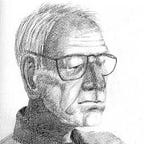Feeding the Crows
I have added feeding the crows to my daily walks to the bakery for luncheon rolls and happy-hour bretzen (large pretzels). A light sprinkling of snow fell overnight and I was wondering whether the crows would see the seeds. I underestimated the visual acuity and brain power of the crows — they had no problems picking up seeds between the snowflakes. Elephants, chimpanzees, and crows are thought to be the smartest in the animal kingdom. By the time I get to the third floor apartment, the flock has found the seeds and they are feasting.
The bird food is sprinkled between chestnut trees Number 209, 211, and 213 alongside the wall that used to be the town wall that circled the village and was first built in 1558. Germans are so organized that they number the trees circling the ring walk as though they were street addresses. We picked these trees because they are directly across the street and we can see them from the “corner office.”
We are waiting for the crows to make a gesture of “thank you” in their fly-byes in the form of loops, rolls, or spins as they swoop towards the large office-type windows of my corner office on the third floor and recognize our faces. I wear the same overcoat and hat to make it simpler for the crows to recognize me spreading seeds.
We are replicating, on a much-much smaller scale, the University of Washington (Seattle) research of human facial recognition by crows and passing human facial recognition to their offspring. After all, Seattle is only 8,472 kilometers away from Bavaria, as the crow flies! Another American idiom similar to beeline. We are trying to see if there is any facial recognition through the windows as we stand in the corner office and watch the crows busily eating the seeds.
The University of Washington has a hour-long video on YouTube of their research, which is worth watching: https://www.youtube.com/results?search_query=crows.
They started their research by determining which mask was most alarming to crows among the students wandering the campus. They selected the mask that made the crows yell the harshest warning “shouts.” Then they radio tagged the offspring of one crow family and followed them into adulthood with the mask. They finally radio-tracked an offspring that mimicked the same alarm shout, suggesting that the facial recognition of the mask was passed down to the offspring. We, on the other hand, were trying to prove that a “good deed” in the form of food, was the opposite of a threatening mask.
We have not forgotten the white swans on our weekly walks by the River Rott. It is amazing to see the cygnets, first photographed in May of 2020, and at the end of 2020 on December 28. Sadly, one of the cygnets did not survive or strayed away from the family. But the rest of the family seems to be in good health and there is “herd immunity” from Covid-19.
The black swans on the surviving section of the village moat, were taken to a heated enclosure during the cold winter months. All black swans originally came from Australia or New Zealand and must be confused by the cold weather in Bavaria this time of year.
